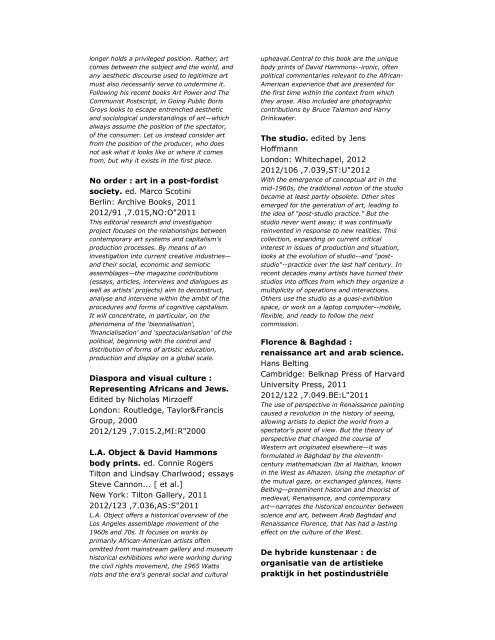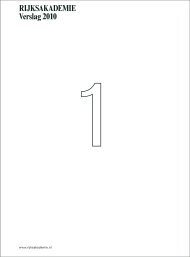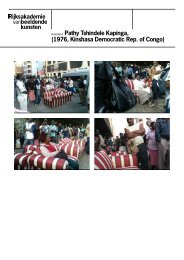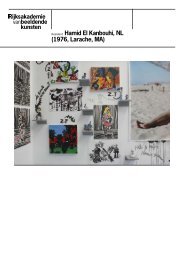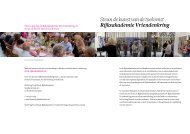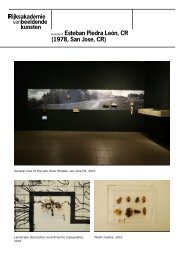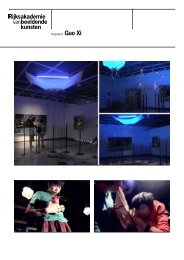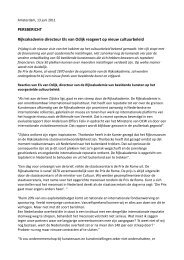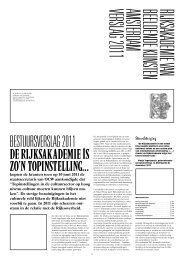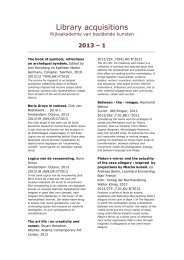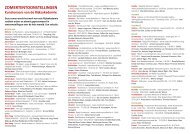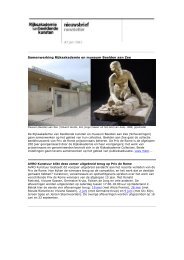library acquisitions 3/2012 - Rijksakademie van beeldende kunsten
library acquisitions 3/2012 - Rijksakademie van beeldende kunsten
library acquisitions 3/2012 - Rijksakademie van beeldende kunsten
Create successful ePaper yourself
Turn your PDF publications into a flip-book with our unique Google optimized e-Paper software.
longer holds a privileged position. Rather, art<br />
comes between the subject and the world, and<br />
any aesthetic discourse used to legitimize art<br />
must also necessarily serve to undermine it.<br />
Following his recent books Art Power and The<br />
Communist Postscript, in Going Public Boris<br />
Groys looks to escape entrenched aesthetic<br />
and sociological understandings of art—which<br />
always assume the position of the spectator,<br />
of the consumer. Let us instead consider art<br />
from the position of the producer, who does<br />
not ask what it looks like or where it comes<br />
from, but why it exists in the first place.<br />
No order : art in a post-fordist<br />
society. ed. Marco Scotini<br />
Berlin: Archive Books, 2011<br />
<strong>2012</strong>/91 ,7.015,NO:O"2011<br />
This editorial research and investigation<br />
project focuses on the relationships between<br />
contemporary art systems and capitalism’s<br />
production processes. By means of an<br />
investigation into current creative industries—<br />
and their social, economic and semiotic<br />
assemblages—the magazine contributions<br />
(essays, articles, interviews and dialogues as<br />
well as artists’ projects) aim to deconstruct,<br />
analyse and intervene within the ambit of the<br />
procedures and forms of cognitive capitalism.<br />
It will concentrate, in particular, on the<br />
phenomena of the ‘biennalisation’,<br />
‘financialisation’ and ‘spectacularisation’ of the<br />
political, beginning with the control and<br />
distribution of forms of artistic education,<br />
production and display on a global scale.<br />
Diaspora and visual culture :<br />
Representing Africans and Jews.<br />
Edited by Nicholas Mirzoeff<br />
London: Routledge, Taylor&Francis<br />
Group, 2000<br />
<strong>2012</strong>/129 ,7.015.2,MI:R"2000<br />
L.A. Object & David Hammons<br />
body prints. ed. Connie Rogers<br />
Tilton and Lindsay Charlwood; essays<br />
Steve Cannon... [ et al.]<br />
New York: Tilton Gallery, 2011<br />
<strong>2012</strong>/123 ,7.036,AS:S"2011<br />
L.A. Object offers a historical overview of the<br />
Los Angeles assemblage movement of the<br />
1960s and 70s. It focuses on works by<br />
primarily African-American artists often<br />
omitted from mainstream gallery and museum<br />
historical exhibitions who were working during<br />
the civil rights movement, the 1965 Watts<br />
riots and the era's general social and cultural<br />
upheaval.Central to this book are the unique<br />
body prints of David Hammons--ironic, often<br />
political commentaries rele<strong>van</strong>t to the African-<br />
American experience that are presented for<br />
the first time within the context from which<br />
they arose. Also included are photographic<br />
contributions by Bruce Talamon and Harry<br />
Drinkwater.<br />
The studio. edited by Jens<br />
Hoffmann<br />
London: Whitechapel, <strong>2012</strong><br />
<strong>2012</strong>/106 ,7.039,ST:U"<strong>2012</strong><br />
With the emergence of conceptual art in the<br />
mid-1960s, the traditional notion of the studio<br />
became at least partly obsolete. Other sites<br />
emerged for the generation of art, leading to<br />
the idea of "post-studio practice." But the<br />
studio never went away; it was continually<br />
reinvented in response to new realities. This<br />
collection, expanding on current critical<br />
interest in issues of production and situation,<br />
looks at the evolution of studio--and "poststudio"--practice<br />
over the last half century. In<br />
recent decades many artists have turned their<br />
studios into offices from which they organize a<br />
multiplicity of operations and interactions.<br />
Others use the studio as a quasi-exhibition<br />
space, or work on a laptop computer--mobile,<br />
flexible, and ready to follow the next<br />
commission.<br />
Florence & Baghdad :<br />
renaissance art and arab science.<br />
Hans Belting<br />
Cambridge: Belknap Press of Harvard<br />
University Press, 2011<br />
<strong>2012</strong>/122 ,7.049.BE:L"2011<br />
The use of perspective in Renaissance painting<br />
caused a revolution in the history of seeing,<br />
allowing artists to depict the world from a<br />
spectator’s point of view. But the theory of<br />
perspective that changed the course of<br />
Western art originated elsewhere—it was<br />
formulated in Baghdad by the eleventhcentury<br />
mathematician Ibn al Haithan, known<br />
in the West as Alhazen. Using the metaphor of<br />
the mutual gaze, or exchanged glances, Hans<br />
Belting—preeminent historian and theorist of<br />
medieval, Renaissance, and contemporary<br />
art—narrates the historical encounter between<br />
science and art, between Arab Baghdad and<br />
Renaissance Florence, that has had a lasting<br />
effect on the culture of the West.<br />
De hybride <strong>kunsten</strong>aar : de<br />
organisatie <strong>van</strong> de artistieke<br />
praktijk in het postindustriële


